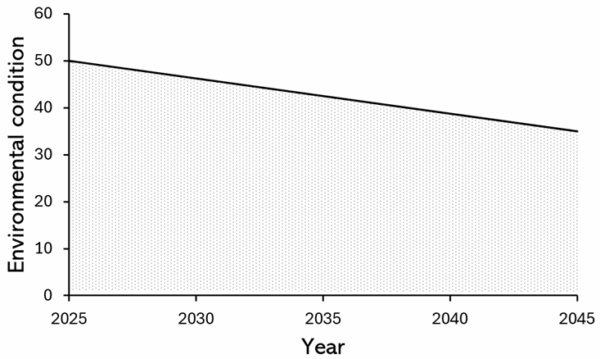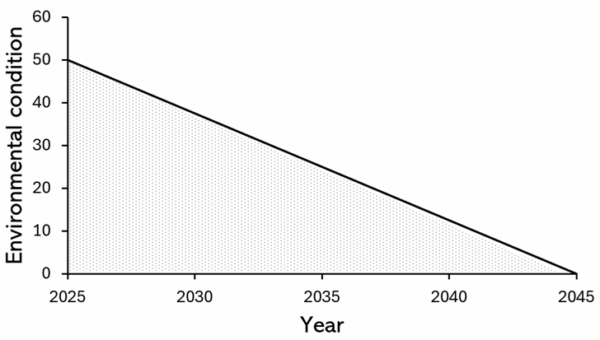437. Environmental offsets 5. Setting the baseline
Biodiversity offset schemes usually aim to deliver “no net loss” of biodiversity, but no net loss relative to what? What is the baseline?
This question is important because the level of environmental damage that has to be offset depends on the definition of the baseline. If the vegetation or the habitat that is lost would have been in relatively good condition if it wasn’t cleared, that means that the offset project has to be relatively large or involve relatively intense management actions.
Conversely, if the cleared vegetation or habitat would have degraded rapidly anyway, a lower-quality offset will be sufficient to offset the loss.
Sadly, we know that many environments are undergoing a slow process of degradation, potentially due to things like weeds, pests, disease, physical damage, or climate change. In those cases, the baseline for measuring damage would be declining. This is illustrated in Figure 1.

Assuming that a development project results in clearing the vegetation at this site in 2025, the shaded area represents the environmental damage that needs to be offset, out to 2045. (I’ll talk about the required duration of offset benefits in another post.)
A challenge is that setting the baseline for assessing the damage caused by an economic project requires a prediction of what would have happened to the vegetation. Any prediction of that sort is obviously uncertain to some extent. That means it could be subject to different judgments.
There is obviously an incentive for a developer to claim that the area they will clear would have degraded quickly. In Figure 2, we can see that relatively rapid degradation results in a smaller level of environmental damage that needs to be offset (a smaller shaded area relative to Figure 1).

Those who manage a biodiversity offset scheme need to be aware of this incentive and have measures in place to guard against gaming of the system. This could include setting maximum allowable rates of assumed degradation, based on empirical evidence about what is happening in similar environments. Perhaps that could be based on an uncleared reference site in the same region.
A concern that has been expressed about a declining baseline, like those in Figure 1 or Figure 2, is that it effectively locks in the assumed loss (Maron et al. 2015).
“Where this counterfactual scenario, or ‘crediting baseline’, assumes a future trajectory of biodiversity decline, the intended net outcome of the offset trade is maintenance of that declining trajectory. If the rate of decline of the crediting baseline is implausibly steep, biodiversity offset trades can exacerbate biodiversity decline.” (Maron et al. 2015)
They found evidence that assumed rates of decline that were acceptable in Australian offset schemes were often unrealistically high, resulting in offset assessments that were favourable to developers but bad for the environment. This makes it even more important to try to ensure that assumed rates of decline at the impact site are not unrealistically high, because whatever is assumed will become the reality.
Another response to these observations is the idea that offset schemes should aim for something better than no net loss. For example, the scheme in operation in South Australia aims to deliver offsets that deliver benefits 10% greater than the impacts. It’s hoped that this will prevent the long-term decline that is observed in many environments. It hopefully avoids the locking in of decline, provided that the rest of the scheme is well designed and implemented.
Further reading
Maron, M., Bull, J.W., Evans, M.C. and Gordon, A. (2015). Locking in loss: Baselines of decline in Australian biodiversity offset policies, Biological Conservation 192, 504–512.